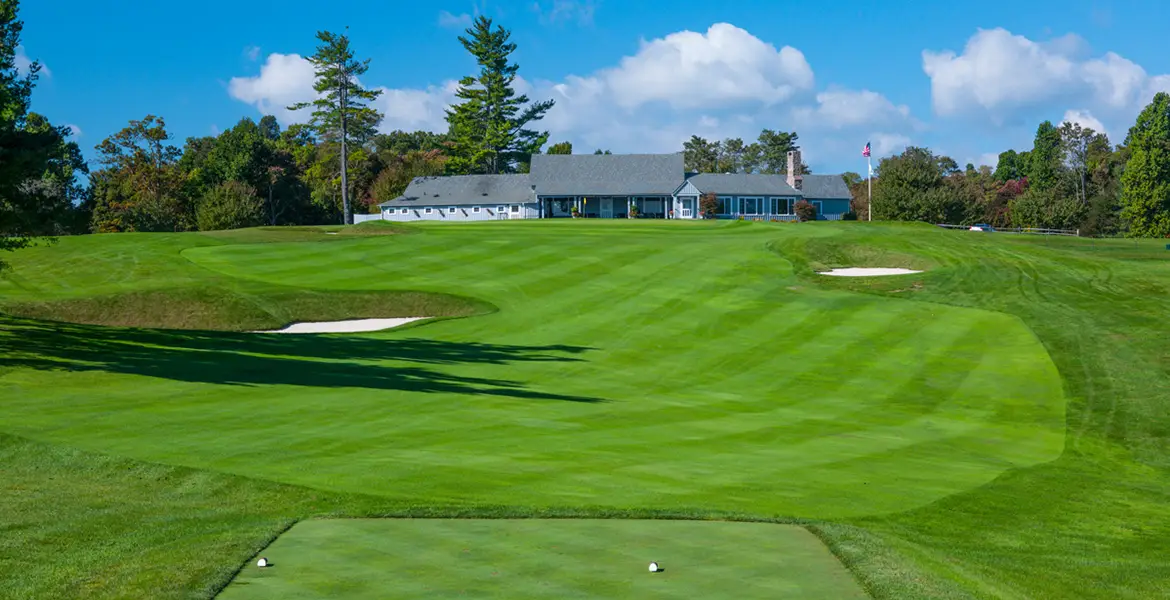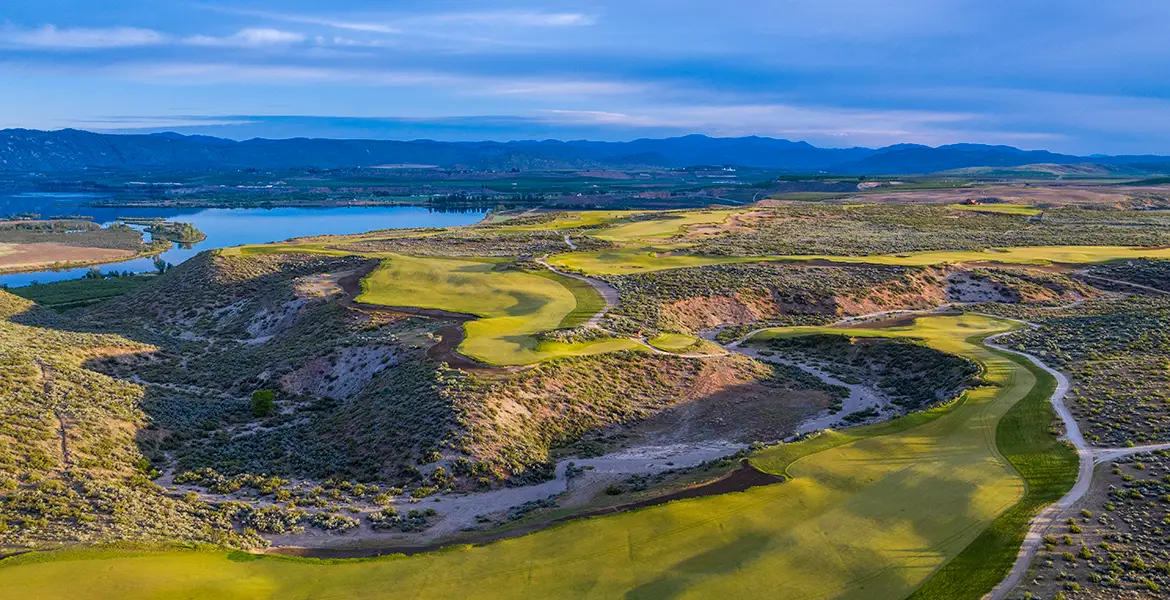When you stroll the narrow, gravel streets of Colonial Williamsburg in Virginia, you’re walking through a living museum—one where history comes alive and centuries merge as visitors and costumed interpreters share the experiences that defined Colonial America. Just one facet of the triad of historic sites that includes nearby Jamestown and Yorktown, Williamsburg’s attractions extend to theme parks, water parks, wineries, and museums—plus dozens of local eateries where a good plate of stew and a frothy tankard of ale are yours for the asking. Golf wasn’t a pastime in 18th century Williamsburg, but it’s a popular pursuit there now, with a variety of strong courses that make the most of their natural, eastern Virginia settings.
Here’s a list of the top courses to play when you’re visiting the Williamsburg area. You may or may not make history of your own on them, but you’re sure to be challenged and to enjoy the unique experiences each course offers.
The River Course at Kingsmill Resort
If you’re looking for a full-on, luxury golf resort where southern hospitality is a real thing, look no further than Kingsmill Resort. Set on the banks of the James River, Kingsmill offers a range of accommodation options—from comfortable, modern guest rooms to roomy cottages to a four-bedroom private estate perched right on the river with its own infinity pool and private chef. Along with 63 holes of golf and a golf academy, there’s a lavish spa, three swimming pools, jet skis and pontoon boats, and a range of dining options to suit every occasion and taste. But the golf is the headliner here, highlighted by The River Course, a top 100, player-friendly, Pete Dye design that has hosted PGA and LPGA Tour events. The course offers views of the broad, flowing James from many of its imaginative holes, including the closing three, which are among the most scenic and demanding in the area. The dogleg-right 16th hole is a par four that plays downhill to a plateau green within steps of the river. The 17th is a 188-yard par three that plays right along the river, near the spot where English settlers arrived in the early 1600s. At the closing hole, your tee shot must carry an inlet to reach the fairway of the dogleg-left par four, where if you reach a ridge, your ball will pitch closer to the hole, leaving you with a short iron shot to a green that slopes left toward the water. It’s one of the area’s premier courses, and not to be missed.

The Woods Course at Kingsmill Resort
The Woods Course at Kingsmill is shorter than the River, and true to its name, its fairways are lined with trees. Water comes into play on many holes, too—and there’s a fair amount of elevation change on several of the tee shots and approach shots. The course was designed by Tom Clark and Virginia native Curtis Strange, and it’s the kind of walk in nature that may make you think about what this land was like when those settlers first arrived. The course has some terrific holes, like the dogleg-right 13th, a short par five whose lakefront green is reachable in two if you can steer your tee shot through a corridor of trees and judge your approach shot to the low-lying green properly. Water comes into play again at the 18th, where your approach shot is do-or-die to a green surrounded on three sides by an imposing lake. While you’re at Kingsmill, the Plantation course from Arnold Palmer and Ed Seay is a good choice for a second 18 of the day. It mainly plays through corridors of homes, but there are many good holes and greens that require careful concentration.

Gold Course at Golden Horseshoe Golf Club
Golden Horseshoe has 45 holes of golf awaiting its eager visitors, and every one of them is worth playing. The Gold Course dates to 1963, when Robert Trent Jones Sr. did the design chores. His son, Rees, made changes in 1991 when he was called upon to add the Green Course to Golden Horseshoe’s lineup, and the Gold Course they produced is a stout test that has hosted a USGA championship. Its fairways are pinched by trees; the greens run fast and are well-defended by sand and water; and the course is routed around a deep valley that can make finding a level lie a tough chore. The par threes all require carries over water, starting at the 200-yard 3rd hole. It only gets more fun and challenging from there, with tight fairways and doglegs predominating right to the end. The 15th hole is a 634-yard par five. Hole 16 plays to 170 yards from an elevated tee, with a large but sloping green that makes two-putting tricky. Water awaits on the par-four finishing hole, too—a dogleg-left where your approach shot is played down to a green bordered on the left by a pond.

Green Course at Golden Horseshoe Golf Club
Like its sibling, the Green Course is a stern test. The course hosted the USGA Senior Women’s Amateur in 1998 and the U.S. Women’s Amateur Public Links in 2004, so you know it’s strong enough to challenge any player. Many of the fairways of this wooded course feature sideline mounds that can help keep your ball in play, but woe betide the player whose ball lands to the wrong side of them. Undulating greens, often presented at angles to the fairways, make approach shots tricky. Two holes that players frequently comment on include the downhill par-three 11th, with its forced carry over a marsh to a green set in a wide bowl ringed by bunkers, and the closing hole, a 500-yard par five that snakes its way through a stand of tall trees and over water to an upturned saucer green guarded by sand. The club’s sporty Spotswood nine is actually its oldest, having debuted in 1947. RTJ Sr. updated those holes when he came to design the Gold Course, and it’s worth a visit, too, if time permits.

Jamestown Course at Williamsburg National Golf Club
The pair of courses at Williamsburg National offer two distinctly different experiences. The Jamestown Course, from the Nicklaus Design Group, stretches to 7,000 yards from the tips, but there are five sets of tees so it can accommodate mortals as well as golf gods. Keeping your tee shots out of the trees will be one of the chief challenges here, but it’s not an overly punishing track. There aren’t too many fairway bunkers that should come into play and the greens tend to be subtle rather than wildly undulating. But there are a lot of fun holes, like the short par-three 8th, where you tee off over water to a wide but shallow green; the dogleg-left 11th calling for a precise second shot to a tilting green guarded in front by a deep bunker; and the dogleg-left 15th, where your tee shot has to avoid both a bunker and a large tree at the corner. It’s a course you can score well on, but to do so you’ll want to be able to move the ball both ways off the tee.

Yorktown Course at Williamsburg National Golf Club
Williamsburg National’s Yorktown Course, another Tom Clark design, also calls for accuracy off the tee to avoid visiting the woods. There’s more water to navigate around than at the Jamestown Course, and the back nine is particularly fun, since it features three par threes, three par fours, and three par fives—giving players lots of birdie opportunities. The par-four 7th hole has water all the way down the right-hand side, with bunkers on the left and a green with yet more water to beware. The par-three 14th has one of the most severe two-tiered greens you’re likely to see; find the right tier—or else. The two closing holes are both knee-knockers, with water creeping in close on the left on the 17th and a reachable green at the par-five 18th that’s protected by deep bunkers and troublesome mounds.
The Yorktown Course at Williamsburg National Golf Club
is our beautiful #GolfCourseOfTheDay!
submitted by: Rock Head Danny Lloyd pic.twitter.com/e3SgVpuwsu— Rock Bottom Golf (@RockBottomGolf) December 11, 2017
The Blue Heron and Blackheath Courses at Ford’s Colony Country Club
Though both publicly accessible courses at Ford’s Colony include several holes with generous fairways, there are tight spots, too, and wetlands to negotiate on many of them. The Blue Heron course is the tighter and longer of the two at 6,928 yards from the tips and plays like target golf in spots. Being able to move the ball both ways off the tee is again an advantage here. The holes between the 8th and 13th run through a scenic stretch of woodlands and wetlands; they require not just accuracy off the tee but a deft touch around the greens. The Blackheath course is arguably even more picturesque and presents a nice variety of challenges itself. Water comes into play on 13 holes, and nine of its holes are doglegs that call for careful club selection and shot shaping.

Kiskiack Golf Club
Trees come into play frequently at Kiskiack, too. (Notice a trend here?) But that’s appropriate for its setting on a natural, Virginia low-country bluff. Kiskiack is a walkable, player-friendly design by John Lafoy that features strategically placed fairway bunkers and mounds. Its greens have lots of movement and, often, pesky drop-offs. The 368-yard par-four 9th is a great hole, with water up the left and a green hidden behind a trio of deep bunkers. Hole 11 is a sweet, 200-yard par three that’s all carry over water to a sharply sloping green. The 503-yard 18th is one of the Williamsburg area’s best finishing holes. From an elevated tee, you play downhill to a fairway bordered on the left by a lake. The hole then twists left over the corner of the lake and through a saddle to a fairway speckled with bunkers before culminating at a deep but narrow green that has more sand both left and right. It’s a fitting conclusion to a course that starts strong and never lets up.

Stonehouse Golf Club and Royal New Kent Golf Club
Though they’re not technically in the Williamsburg area, no one should head that way on a golf trip without planning to make the short trek up I-64 to play at least one of these Mike Strantz gems. Strantz started his career working for Tom Fazio, and went on to create his own design company. Before his untimely death from cancer at age 50, Strantz gave us some highly imaginative (and challenging) courses, including True Blue, Caledonia Golf & Fish Club, and Bulls Bay in South Carolina; Tobacco Road and Tot Hill Farm in North Carolina; and the renovation of two California courses in Silver Creek Valley Country Club and the Shore Course at Monterey Peninsula. His two courses just up the road from Williamsburg are rated among Virginia’s best—public or private. Stonehouse Golf Club in Toano was named “Best New Upscale Public Course in the Nation” by Golf Digest when it debuted in 1996. Strantz wanted to create a natural, mountain-style course in the wooded hills of Toano, and his design there features wide fairways but lots of possible trouble in the form of deep bunkers and large greens that are often sited along the edges of natural cliffs. The sweeping, two-tiered, boomerang-shaped green at the par-three 8th hole is pure Strantz; high on the left, low on the right, the green hugs a centerline bunker and could serve up one of the most challenging and fun putts you’ll ever face. The closing hole, a 500-yard par five, bends steadily left and demands that you avoid a steep drop-off into oblivion on the left if you’re to finish with your head held high.

At Royal New Kent, located a few miles farther north up I-64, Strantz’s intention was to create a course that paid homage to the links courses of the British Isles. From the tips, it steps out to more than 7,400 yards with a 154 slope rating. It was also named “Best New Public Course in America” the year it opened (1997), and if you see it once you’ll know why. From the first tee, you’ll play over rough-choked hills, through corridors routed between dunes, down avenues flanked by tall fescue grasses, and around walls of bunkers from which balls can’t be advanced—all en route to angled and canted greens that often feature steep drop-offs to one side or another (or both). No two holes are remotely alike—and none are flat, either. There are blind shots to contend with, such as on your approach shot on the stellar par-four 8th hole, and many forced carries over wetlands and streams choked with vegetation. Every hole has its own memorable feature, like the horseshoe bunker fronting the green at the par-five 10th; the 62-yard-deep, hourglass-shaped green at the par-three 12th; and the closing hole’s peninsula green, where you can end your round with birdie—or ignominy. Strantz courses never disappoint, and though they may play tough, you’ll never regret having done battle with one.








I’ve played all of these–many times. I’m in Williamsburg one week a month, and love all these courses. They are all located close to the city center and easy to get to. Definitely worth a trip to Williamsburg to play.